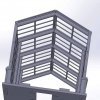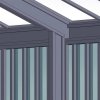Osgood
Western Thunderer
Early plates were quite large castings but soon became sectionalised enabling smaller plates to be used.
I would have thought the bridge shown below would have used three plates with joints at red lines - this makes sense when you look at the holding down bolt locations. Bolts were only used at ends of plates - not in centre where they might stress the plates (the plates sat on timber packers above the main girders, so bolts really just located plates and stopped excess vertical free play).

Also note that most plates have uniform thickness webs at ends, so there would be a double-thickness web along joint lines, similar to the outer end of the plates?
Not always though - I have an early 20T Bartlett bridge using 1 x 8ft w x 8ft plate and 1 x 8ft w x 7'11 1/2", instead of using two identical plates.
The joint is offset by 1/2" and the pattern spacing changes by 1" in centre - oh well.
I would have thought the bridge shown below would have used three plates with joints at red lines - this makes sense when you look at the holding down bolt locations. Bolts were only used at ends of plates - not in centre where they might stress the plates (the plates sat on timber packers above the main girders, so bolts really just located plates and stopped excess vertical free play).

Also note that most plates have uniform thickness webs at ends, so there would be a double-thickness web along joint lines, similar to the outer end of the plates?
Not always though - I have an early 20T Bartlett bridge using 1 x 8ft w x 8ft plate and 1 x 8ft w x 7'11 1/2", instead of using two identical plates.
The joint is offset by 1/2" and the pattern spacing changes by 1" in centre - oh well.


 .
. 







































